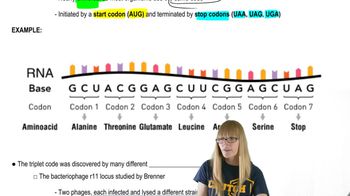Here are the essential concepts you must grasp in order to answer the question correctly.
Translation
Translation is the process by which ribosomes synthesize proteins from messenger RNA (mRNA) templates. During translation, the ribosome reads the sequence of codons in the mRNA, and transfer RNA (tRNA) molecules bring the corresponding amino acids to form a polypeptide chain. This process occurs in the cytoplasm and is essential for gene expression, as proteins are crucial for cellular structure and function.
Recommended video:
Codons
Codons are sequences of three nucleotides in mRNA that specify a particular amino acid during protein synthesis. Each codon corresponds to one of the 20 amino acids or serves as a stop signal for translation. The genetic code, which is nearly universal among organisms, dictates how sequences of nucleotides are translated into the amino acid sequences of proteins.
Recommended video:
Ribosomes
Ribosomes are complex molecular machines found within all living cells that facilitate the translation of mRNA into proteins. Composed of ribosomal RNA (rRNA) and proteins, ribosomes can be found free in the cytoplasm or attached to the endoplasmic reticulum. They play a critical role in decoding the mRNA sequence and catalyzing the formation of peptide bonds between amino acids, thus building proteins.
Recommended video:
 Verified step by step guidance
Verified step by step guidance Verified video answer for a similar problem:
Verified video answer for a similar problem:

